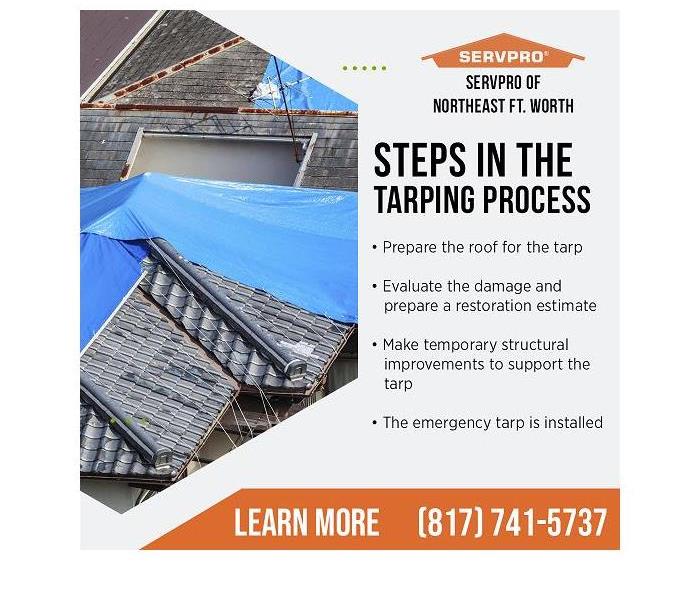Why Tarping Should Be Implemented Quickly After Storm Damage That Causes Water to Enter the Home
5/6/2021 (Permalink)
Blog Summary: SERVPRO of Northeast Fort Worth highlights the benefits of quickly securing emergency tarping services after storm damage.
A locally owned and operated business, SERVPRO of Northeast Fort Worth is the leading storm damage restoration company serving the Fort Worth, Keller, and Park Glen areas with continuous coverage twenty-four hours a day, seven days a week. When severe weather damages a home, SERVPRO technicians are ready to respond to any disaster.
The Importance of Emergency Roof Tarping When Disaster Strikes
The roof, an essential part of any structure, is designed to protect the occupants and their belongings from the elements. A tiny roof leak can cause major property damage issues, including potential water damage to ceilings and walls, structural damage to support beams, and a full-blown mold infestation hidden in the attic and behind walls.
Unfortunately, most instances of major roof damage occur during severe weather situations. Intense thunder, torrential rain, pelting hail the size of a quarter, high winds, and even tornadoes wreak havoc on the roof. Shingles are ripped up and blown away. Plywood sheeting takes flight in high winds. The exposed attic yawns to receive rain and hail.
The roof damage may not be limited to one roof. Most likely, dozens, if not hundreds, of homes in the same area have been impacted to some extent by the wind, rain, and hail. In some instances, limbs and trees may have toppled onto the home, inflicting damage to the entire structure and not just the roof.
It could be days before a roofing contractor is able to inspect the damage and weeks before the damage is repaired. In the meantime, unless an intermediate solution is found, buckets of rain will pour through the roof, expanding and worsening the extent of the water damage. In warm, moist conditions, mold can begin to grow in one to two days.
The Benefits of Emergency Tarping
Homeowners may wait for weeks before receiving proper roof repair services. The intervening solution is emergency roof tarping. Emergency roof tarping can be the difference between minor water damage in the attic or collapsed ceilings, ruined flooring, significant structural damage, and a massive mold infestation. A minor leak may lead only to an inconvenience. A massive breach in the roof could be unhealthy and very dangerous.
Is Emergency Roof Tarping Effective?
Homeowners can minimize water damage with emergency roof tarping. Tarping effectively stops the leak by covering the damaged area. Stopping the flow of water, even if it is minuscule, prevents the damage from expanding. It also gives the wet areas of the attic and ceiling time to dry out.
Many roof leaks are small and barely noticeable at first. Most homeowners do not regularly inspect the roof after a storm, and many homeowners who do visually inspect the roof after severe weather are not sure what to look for. If water damage is negligible and limited to an obscure or inaccessible area such as the attic, the damage may go unnoticed for quite a while.
The main benefit of emergency roof tarping is to stop a small roof leak that does little damage from becoming a larger roof leak that causes widespread damage. Though emergency roof tarping is temporary, it works well in the short term until roofing services can be scheduled.
Steps in the Tarping Process
Step #1: Prepare the roof for the tarp.
Professionals with ladders and safety gear must clear out any debris such as damaged plywood, shingles, and other roofing materials.
Step #2: Evaluate the damage and prepare a restoration estimate.
The area of concern must be inspected to assess the damage and estimate the cost of the repairs.
Step #3: Make temporary structural improvements to support the tarp.
Plywood and support timber are applied to the damaged area before the tarp is installed. The additional construction supports the tarp and serves as a second water shield in case the tarp fails.
Step #4: The emergency tarp is installed.
Workers place the tarping on top of the plywood and secure the tarp with lumber. Tarping is only temporary and may not completely stop all water leaks. Water damage losses may expand until the roof is permanently repaired, and these additional minor losses will be added to the insurance claim.
Why Would a Homeowner Need Emergency Tarping?
What are some situations where a homeowner would need emergency roof tarping?
- Hurricanes, tornadoes, or severe weather damage a roof
- Delays in roof repairs require interim tarping
- High winds cause branches or trees to fall on a roof
- A home inspection prior to a home sale turns up a roof leak
The experts at SERVPRO of Northeast Fort Worth specialize in the cleanup and restoration of property damage caused by hurricanes, tornadoes, or severe weather. Technicians can provide emergency tarping, board-ups, security fencing, pack-ups, and storage.
To learn more about storm damage restoration in Keller, TX, contact SERVPRO of Northeast Fort Worth, TX, at (817) 741-5737 or email the office at office@SERVPROnortheastftworth.com.





 24/7 Emergency Service
24/7 Emergency Service
